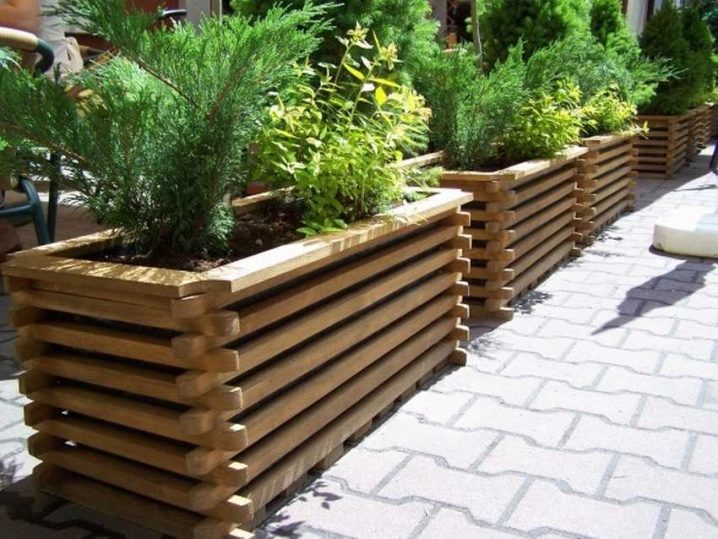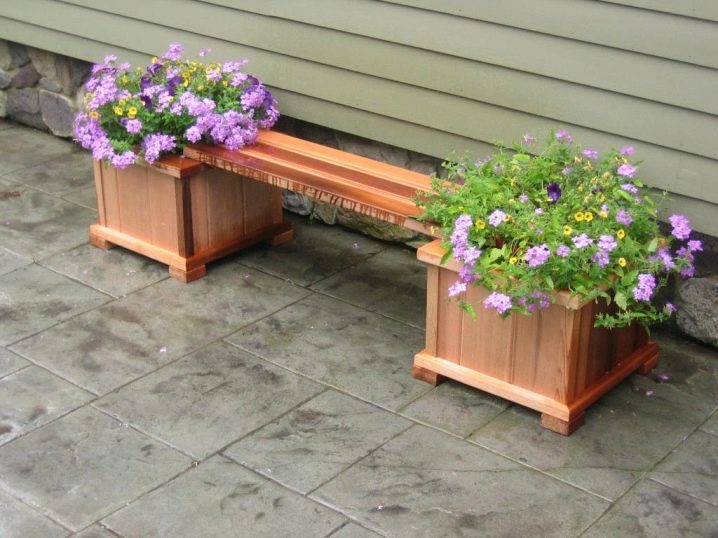Features of wooden flower pots

Flowerpots are irreplaceable assistants in the phytodesign of the interior of residential premises, business spaces and the design of garden and park landscapes. They help to properly organize the space for vertical or horizontal gardening, give the floristic design a complete look and emphasize the stylistic harmony in the interior. Decorative vases are made from a variety of materials: plastic, metal, terracotta, wood and even concrete. But it is with a natural tree that living greens form the most successful and organic pair. Wooden pots are universally suitable for interior and landscape designs.

Solid wood is a completely environmentally friendly material with unique decorative qualities that harmoniously fit into various styles.

Peculiarities
Wooden pots for flowers, like any wood products, evoke a feeling of unity with nature, increase the degree of warmth and comfort in the interior, creating an inviting atmosphere.

We can talk about the advantages of wooden products for a long time.
- Environmentally friendly. 100% safe for human health natural materials are used for their manufacture.

- Strong and reliable. They do not break like ceramics and do not crack under the influence of negative temperatures or mechanical stress, like plastic.

- Mobile. Due to their low weight, they are easy to move around the territory, which is very convenient when changing compositional solutions in landscape design and floristic decoration of different segments in the garden.

- Hygienic. Many types of wood have antibacterial activity, so harmful organisms do not take root in such an environment.

- Breathable. Good air circulation inside the wooden flowerpot eliminates overheating and drying out of the earthy clod.

- Acceptable for the price. Of course, we are not talking about exclusive products made of valuable mahogany or ebony, the purchase of which costs a round sum. There are many original solutions from less expensive varieties of wood: linden, aspen, larch, ash, beech, birch, alder. The most affordable options are homemade pots made from different parts of trees (stump, trunk, bark) or lumber (beams, boards, logs).

The main disadvantage of wooden structures is hygroscopicity.
Contact with water causes deformation of their surface and provokes the development of decay processes. Therefore, it is important that the outside of the product is treated with special moisture-proof compounds, and inside it has a waterproofing insert.

Design
Wooden pots impress with a variety of designs: from the simplest ready-made options in the form of boxes and flowerpots to unusual handmade flower girls.

Classic
In traditional models, cube-shaped pots have open sides, and a niche for planting plants is voluminous. This is an ideal solution for group placement of ornamental foliage plants or under carpet planting of grass.Dimensional options with a large internal volume are suitable for large-sized ones: yucca rostrata, umbrella shefflers, zamiokulkas, medium-sized ones for cross-stephium, sedge bushes, money tree, and succulents look great in compact ones.


Cache-pot "Royal"
Unusual table pots "Royal" in delicate pastel colors (pink, mint, blue, light yellow), in white and black will harmoniously complement the exterior of terraces, gazebos and pergolas or the interior in the French country style. Floristic filling of decorative flower boxes made of natural wood can be anything you like. The composition of ampels with picturesque shoots falling from all sides looks impressive. The piano looks no less impressive and stylish, evenly filled with lush undersized flowers.

Floristic with handle
These pots are used by florists for compositions of fresh flowers or sweets (macarons, candies). They can be made in the form of drawers with one high or rope handle or two rope handles, mini-chests of drawers, a gift box with satin ribbon handles. They are decorated with carved decor or finished using decoupage technique.

From the stump
From the seemingly unsightly lower parts of a felled or broken tree, stylish flower beds in eco-style are obtained. The stump is cut to the desired height and drilled around the entire circumference of the hole cut. A chisel is used to hollow out the core. Inside, the product is covered with wood varnish, lined with polyethylene or put a plastic container as waterproofing. Decorative pots-stumps are suitable for planting any flowers, but compositions with marigolds, forget-me-nots, pansies, primroses, begonias and daffodils look best in them.

From the trunk of a tree
Planters made from a solid tree trunk organically complement rustic garden landscapes and trendy Scandinavian interiors. They are made according to the same principle as when making pots from a stump, making a longitudinal notch for planting plants. The presence of rustic accents adds warmth to modern cold industrial interiors in loft or steampunk design.

From timber and boards
You can build stylish pots from the remnants of lumber. The design of such containers can be very different: with solid or lattice walls, in the form of simple square or rectangular boxes, flower beds in the form of a miniature fence for oblong flower pots. Plank pots look equally good in landscape and interior designs. Another interesting option for decorating the site is boxes with built-in trellis for loaches and vines.

From the bark
Birch bark flower girls are an ideal decoration for rustic interiors. The frame is made of slats with different sections. The resulting structure is pasted over with birch bark and painted with interior acrylic paints, and twine is used to decorate the joints (edges). The pots-gutter made of bark with side walls in the form of tree cuts looks original. This is no longer just decorative packaging for flower pots, but a full-fledged decor that can not only decorate and beautify the interior, but also play the role of an accent, drawing attention to a specific area of the room.

Popular models
Cubo de madera
The planter is a closed seamless construction of a clear laconic shape with a round hole for planting a plant. They can be easily integrated into any modern interiors of office spaces, apartments and houses, cafes and restaurants. But they look the most advantageous in eco-design, minimalism, hi-tech, loft and urban style. Such pots multiply the attractiveness of living plants, emphasizing with their shape the graphic nature of their silhouettes and repeating the foliage patterns with the linear structure of wood.

Compositions of artificial flowers and decorative branches look no less expressive in them.

With built-in autowatering system
The demand for pots with automatic bottom irrigation is due to the quality and convenience of caring for green pets. The tank is equipped with a water level indicator, substrate dryness and a drainage tube.

Advantages of models with automatic watering function:
- strict control of water supply to plants;
- preserve water supply, and even moisture-loving plants are enough of it;
- release the owner from the need for manual watering for 2-4 weeks;
- suitable for any flowering and decorative deciduous plants;
- the substrate is rich in minerals that regulate the pH of the soil and ensure normal root development.

On rollerskates
Floor pots for flowering annuals and perennial dwarf shrubs are indispensable for the formation of spectacular hedges by building a number of flowerpots. The use of flower beds of different heights allows you to create embossed multi-tiered compositions. The design of such pots is extremely laconic: simple shape of the body, strict sides, natural texture of the boards. Equipping the boxes with small rollers ensures the mobility of the structures.

Under the windowsills
Planters in the form of elongated drawers in the classic style are used for vertical gardening of kitchens, living rooms, loggias and are mounted under windows, on walls. They are suitable for planting indoor grasses, ampels, low indoor potted plants with an erect stem. These products look great in Provence, Eco, Loft and Scandi designs.

High
Floor planters in the form of tall drawers of perfectly adjusted elongated shape are used mainly in landscape design. The technology of alternating joining of front and side strips with minimal gaps allows to achieve laconic expressiveness of shapes and lines. The clear geometry of narrow flowerpots harmoniously fits into the classic style of gardens and parks with lawns, trimmed green fences and lush flower ensembles. Due to the significant internal volume, they will be good for young conifers: thuja, junipers, mountain pine.

Narrow high drawers can be used to decorate small balconies and winter gardens, since their installation does not require a lot of space.

How to choose?
When choosing a pots, you need to take into account a number of criteria.
- The size. This parameter depends on the size of the flower pot. To calculate the size of the pots, you need to measure the height of the pot and two diameters: in the lower and upper parts, add 1-1.5 cm to each value.

- Colour. The colors of the pots are chosen taking into account the appearance of the plants. For bright, lush flowering plants, stands in neutral, calm shades are ideal, which will enhance the beauty of the flowers, and not overshadow it with the brightness of the colors. The coloristic solution of home pots should be in harmony with the colors of the background finish, furniture, textiles and decor.

- The form. It is chosen for certain types of plants. Rectangular floor decorative planters are suitable for bulky high-stemmed palms. Plants with spreading leaves will feel comfortable in cone-shaped or trapezoidal vases, and in round ones with rounded crowns, in low and wide ones - succulents, which include the popular money tree.

- Proportions. In this case, the reference point is the height of the plant. For undersized representatives of the flora, decorative stands are chosen taking into account the height of their green parts. Hanging houseplants need hanging-type models, moreover, heavy ones, so that the hanging shoots do not outweigh or overturn the flowerpot. Low bowl-shaped containers are filled with orchids, aloe, succulents.

Care
Following simple recommendations will help preserve the beauty of wood pots and extend their service life in the open air or at home.

Street
- Protect wooden structures from contact with water during irrigation of lawns and green spaces. If the site is equipped with an automatic irrigation system, it is important to ensure that the spray does not fall on the flowerpots.

- Keep planters clean by regularly removing surface dirt that settles on them when landscaping or excavating. At least 2 times a year, the pots should be washed with mild detergents and treated with antiseptics.

- For the winter, place the pots in closed unheated rooms or under sheds, where there is no access to atmospheric precipitation.

- Preventive treatment with deep penetration biosecurity every spring and / or autumn. When cracks appear on the surface, the products are covered with soil, defects are putty, polished and painted.

Home
- Use a damp cloth to clean the surface, and use a dry cloth for cleaning before sanding.

- Remove stubborn dirt with a delicate detergent. The use of bleach is unacceptable.

- Solid wood must not be polished with silicone-based products that leave sticky marks.

- Vases are treated with mineral or vegetable oils (linseed, tung, teak) once every six months to emphasize the natural texture of the tree and give it a cozy matte color.

For more information on the features of wooden flower pots, see the video below.













The comment was sent successfully.